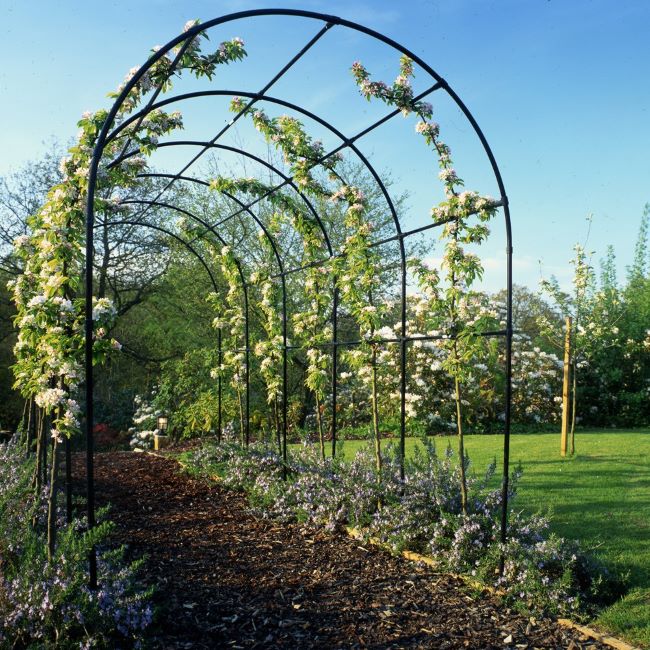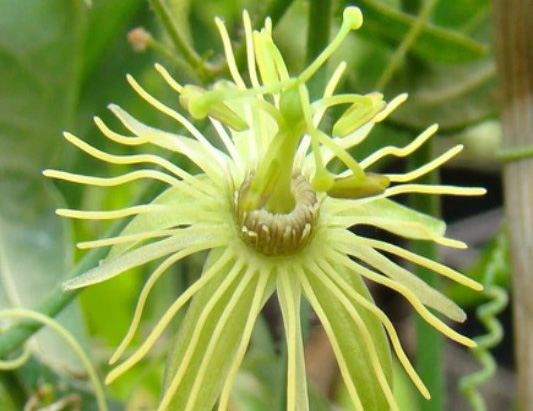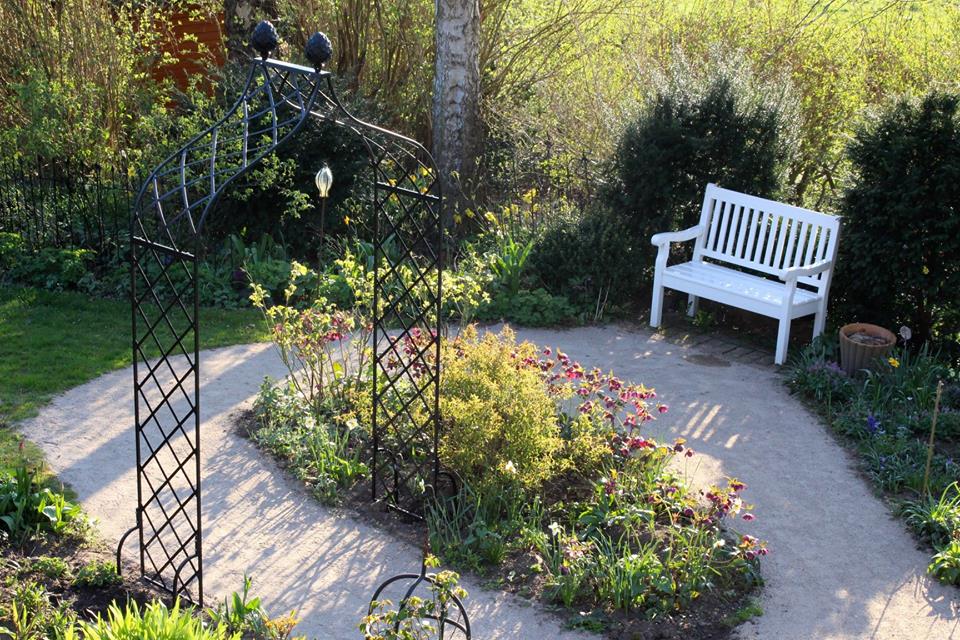Garden arches are not just for climbing roses! While a rose-laden arch is indeed beautiful, such a planting may not suit many architectural or garden design styles, or match a homeowner's needs. However, the versatile structure itself can enhance any garden, serving both aesthetic and practical purposes. Whether you're looking to maximize your growing space or seeking new design ideas, incorporating a well-built garden arch offers many exciting ways to transform your landscape. Let's forego the roses, and examine some other exciting opportunities.

Unique Ideas for Growing Vertically on Arches and Arbors
Growing Fruit Trees on a Garden Arch
Many of us know we can grow fruit trees in the home garden in columnar form or as an espalier, but you may not have heard of a fruit tree arch. Simply put, it's a garden arch designed to support fruit trees, one planted on either side, until they meet at the top, creating a uniquely beautiful seasonal display. Imagine walking under a garden arch of apple blossoms in spring, sitting on a shady bench under a canopy of green in summer, and finally walking by, picking a crisp, ripe apple in fall.
It may sound too good to be true, but with the right trees, it's really not that hard! Thanks to the recent trends in urban gardening, there are several different types of columnar apple trees available perfect for growing on a garden arch.
These trees grow 8-10 feet tall and 2-5 feet wide and produce fruit all along the trunk on short spurs. No pruning is required, other than removing any occasional winter damage. As with all apple trees, you will need to plant two different varieties that overlap bloom for cross-pollination in order to produce fruit. If there's a crabapple tree within 100 feet of where you plan to place your arch, that will work, too. Crabapples are often grown in orchards as their bloom time is longer and they are excellent pollinators for many varieties of apple.
Due to the narrow growth habit, these trees tend to have a neat, rather stately appearance. While such a fruit tree arch would fit perfectly in your edible garden, it is elegant and tidy enough to be placed at your front entry or as a focal point in a formal garden. You could also choose to grow these on a pergola, which is essentially a very long arch, creating a tunnel effect. Depending on the width of the pergola you choose, you could place it over a pathway, or site a bench, bistro set, or even a dining set underneath to make the most of your entertaining space.
- Choose a site in your garden that is well-drained and receives at least 6 hours of sun. Plant one tree on each side of the arch.
- Because most fruit trees are grafted, be sure to keep the graft union above the mulch or soil line to prevent shoots growing from the rootstock.
- As the trees grow, just attach the trunks to the sides and top of the garden arch with a flexible tie that won't cut into the bark. (Nylon pantyhose work well).
As with any fruit tree, at some point you may need to treat for various insects and disease. Beware of planting apple, crabapple, or serviceberry trees within 100 yards of juniper species, as cedar apple rust may result. While rarely permanently damaging to either plant, fruit may be severely affected. Many juniper species are the alternate host for this fungus, most often Juniperus virginiana (native Eastern red cedar) or J. scopulorum (Rocky Mountain Juniper), but also J. horizontalis (creeping juniper), J. chinensis (Chinese juniper), and J. communis (common juniper). The spores can actually spread via wind up to 1 mile.
Your local cooperative extension service can advise you as to the best controls for this and any other issues. Compared to a full-sized tree, though, any maintenance will be far easier to complete, and no ladders required!


Fruit Tree Cultivars for Your Garden Arch
- Scarlet Sentinel Columnar Apple - zones 4-9, needs a different apple or crabapple variety for cross-pollination
- Golden Sentinel Columnar Apple - zones 4-9, needs a different apple or crabapple variety for cross-pollination
- North Pole Columnar Apple - zones 4-9, needs a different apple or crabapple variety for cross-pollination
- Blushing Delight Columnar Apple - zones 4-9, needs a different apple or crabapple variety for cross-pollination
- Sweet Sensation Columnar Peach - zones 6-9, self-pollinating, but increased fruit production with cross-pollination (another peach or nectarine variety)
- Sugar Pie Columnar Nectarine - zones 6-9, self-pollinating, but increased fruit production with cross-pollination (another peach or nectarine variety)
The fruit trees below are not columnar, but the fast-growing shoots are pliable when young so may be trained through or over a garden arch and side branches pruned as needed:
- Elderberry (Sambucus nigra) - zones 3-9, need two varieties for cross-pollination. Prune in spring. Canes 3 yrs old and older should be removed for best fruiting. Very attractive plant with large white flower clusters and glossy black fruit that matures in late summer. Tolerates partial shade. If edible fruit is desired be sure to choose varieties grown for that - many ornamental Sambucus are available but fruit quality is reduced. Elderberries must be cooked - raw fruits are toxic to humans (but birds love them).
- Dwarf Everbearing Mulberry (Morus nigra) - zones 5-10; grows 10 to 15', long production period of full-sized, sweet fruit
- 'Coolidge' Pineapple Guava (Feijoa sellowiana) - zones (7) -10; grows 8 to12' but smaller in the upper parts of its hardiness zone. Very attractive plant with glossy green leaves with silvery-white undersides. Showy early summer flowers have fleshy pale pink sepals and fluffy red stamens. Apricot sized fruit ripens in November and has flavors of pineapple and mint. 'Coolidge' is self-pollinating, other cultivars may require another variety for cross-pollination. Flower petals are edible with a cotton candy flavor.
- Black Surinam Cherry (Eugenia uniflora) - zones 9-11, broadleaf evergreen grows up to 15' but easily pruned to size. Sweet black one-inch fruit ripens quickly in spring, and resemble small pumpkins. 'Lolita' is a cultivar with excellent flavor. Fruit can be eaten fresh or used for jam or pie filling.




Growing Bramble Fruits on a Garden Arch
If you'd like fruit but trees seem too daunting, growing brambles on a garden arch might be your answer. Brambles - blackberries, boyesenberries, and raspberries, are usually thorny plants that grow on long stems, called canes. Some are "everbearing," producing fruit at the ends of primocanes in the fall, and on the lower portions of those canes the following summer. Other varieties produce fruit on second year canes, called "floricanes." There are also thornless types of blackberries.
Plant brambles in full sun (light shade is tolerable but yield may be reduced), one on either side of the arch, and be sure the soil is well-drained. Do not plant where nightshades (tomatoes, peppers, eggplants, potatoes, etc.) have grown before. Loosely tie or weave the canes through the garden arch as they grow. Yearly or twice-yearly pruning will be necessary to crop well.
In case you're wondering, how do you tell a blackberry from a raspberry? When you pick a raspberry, the center is hollow and the core is left on the plant. With blackberries, the core comes off with the berry. Now you know!
Growing a Grapevine on a Garden Arch
Another great choice for a garden arch is a grapevine - the woody trunk and large leaves lend a rustic ambience to the landscape. Grapes are easy to grow, just needing full sun, adequate moisture, and proper pruning once or twice yearly after the trunk is established. Even if you do that wrong you'll likely still end up with fruit, just not as many. I don't even eat many of the grapes I grow on my garden arch, as I enjoy watching the cardinals and other birds harvest them in the fall - it's a great plant for a bird habitat! You can learn more about backyard grape growing in our article here.
Growing Vegetables on a Garden Arch
- Peas, beans, and cucumbers will climb with ease. Most beans have very attractive flowers, and for a tasty and dramatic display you could grow Chinese red noodle beans with long, narrow, maroon pods that grow over one foot long.
- Squash, gourds, and cherry tomato plants will appreciate the support of an arch and save valuable planting space growing vertically. Depending on the planting location, plants may benefit from extra sunlight as they reach the top of the arch. I wove my tomatillos through my garden arch this year, creating a lovely effect with the delicate yellow flowers followed by the drooping papery-husked fruits.
- Red Malabar spinach is tall growing vine with red stems and green leaves used as a spinach substitute that you can harvest all summer until frost. The pink flower clusters are also quite lovely, but should be removed to promote better foliage production (leave a few to bloom and mature so that you can collect the seed for next year, though).
A garden arch in your veggie patch gives you so many options to try new and interesting edibles without losing valuable planting space!




Growing Conifers, Broadleaf Evergreens, and Evergreen Flowering Vines on a Garden Arch
- Weeping conifers are a great choice to grow on your garden arch, as the pendulous branches easily conform to the shape, and drooping branchlets will soften the outline. Excellent candidates include weeping Blue Atlas cedar, weeping white pine, weeping Norway spruce, weeping white spruce, and weeping hemlock.
- Broadleaf evergreens can also be trained over an arch. Fast growing species like loropetalum or pyracantha can be easily grown through or gently attached to the arch while their long, new shoots are young. Though it may take a bit longer, camellia and magnolia are other possibilities.
- Tropical Vines: For those where they are hardy, when grown over a garden arch, angel's trumpet, bouganvillea, mandevilla, clerodendrum spp., and golden dewdrop (duranta) will make an absolutely stunning display.
- Evergreen flowering vines that are hardy above zone 9 are hard to come by but there are a few. If you have a warmer microclimate in part of your garden you might be able to push the zone a bit. Many of these will likely be semi-evergreen to deciduous in the northern part of their range, while some may instead die back and resprout from the roots. Try these on your garden arch for both an evergreen and blooming display:
- Butterfly Vine (Mascagnia macroptera). Orchid-like yellow spring flowers repeat in summer on a 12-15 foot evergreen vine. Zones (possibly 7 with protection)8-10. Very heat and drought tolerant.
- Weeping Bottlebrush (Callistemon viminalis). Bright red fuzzy bottlebrush-shaped flowers put on a spectacular spring show. Small, narrow, evergreen blue-green leaves on arching stems and branches. Grows 10 to 20 feet in zones (7)-11, both aspects cultivar dependent.
- Carolina jessamine (Gelsemium sempervirens): Profuse yellow flowers in early spring, zone 6-10. Related and similar Gelsemium rankinii blooms spring and fall
- Cross Vine (Bignonia capreolata): Large trumpet-shaped flowers of red, orange, or yellow in summer. Native. Can sucker aggressively. Zone 5-9.
- Evergreen clematis (Clematis armandii): White flowers. Zones 7-9.
- Evergreen Wisteria (Millettia reticulata): Deep rose-purple fragrant flowers adorn this twining evergreen vine in late summer. Grows 15-30'. Periodically prune some of the lower stems to keep bottom of arch from looking sparse. Zones (7)8-10.
- Confederate Jasmine (Trachelospermum jasminoides): Highly fragrant white flowers late spring - midsummer. Zones (7)8-10.




Please Note: Our plant recommendations are only suggestions, and may not be appropriate for your particular area. Always consult your local cooperative extension service, master gardener's program, state natural resources department, or trusted independent nursery for information on what plants may be invasive or best grown in your location. Thank you!





